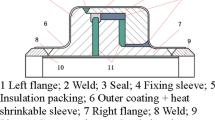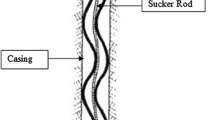Abstract
A sudden leak of 6-inch gas line pipe after being in service for 1 year was observed. The pipe was designed to transport dry gas. The failure had taken place in 6 o’clock position at the stage discharge of the flow process. Specimens from the failed part had taken for laboratory investigation in order to find out the cause of the pipe rupture. Visual and metallographic observations confirmed that the pipe split was due to a crack initiated in circumferential and then turned into longitudinal direction. Sever wall thickness reduction was noticed on the internal pipe surface. SEM observations at the fracture surface revealed features of ductile fracture mode. Corrosion product analysis showed the traces of iron carbonate/iron sulphate. Upon the laboratory analysis, the concluded remarks confirmed that the pipe failed due to the effect of wet fluid (condensate) caused severe wall thickness dissolution resulted in pipe could not stand the continuation at in-service working condition.









Similar content being viewed by others
References
Mason JF (1997) Pipe liners for corrosive high temperature oil and gas production applications. (No. CONF-970332–). NACE International, Houston, TX (United States)
Elazzizi A, Hadj Meliani M, Khelil A, Pluvinage G, Matvienko YG (2015) The master failure curve of pipe steels and crack paths in connection with hydrogen embrittlement. Int J Hydrogen Energy 40(5):2295–2302
Elbasir A, Elganbour K, Elshawesh F, El-houd A (2005) Factors effects on amine corrosion inhibitor efficiency of mild steel in CO2 containing environment. In: Proceeding of the 10th European symposium on corrosion and scale inhibitor (10SEIC) Ann. Univ
Hadj Meliani M, Azari Z, Pluvinage G, Matvienko YuG (2010) Two parameter engineering fracture mechanics: calculation of the relevant parameters and investigation of their influence on the surface notch. In: Proceeding of the NATO-workshop “Corrosion protection of pipelines transporting hydrocarbons”, 26–28, Biskra- Algeria
Soudani M, Hadj Meliani M, El-Miloudi K, Fares C (2017) Corrosion effects and green scale inhibitors in the fracture mechanics properties of gas pipelines. J Struct Integr Life 17, 25–31
Hadj-Meliani M, Azari Z, Matvienko YG, Pluvinage G (2011) The effect of hydrogen on the master failure curve of APL 5L gas pipe steels. Procedia Eng 10:942–947
Frignani A, Monticelli C, Zucchi F, Trabanelli G (2005) Benzotriazole derivatives as inhibitors of iron acid corrosion. In: Proceedings of the 10th European symposium on corrosion inhibitors (2), pp 955–968
Schmitt G, Feinen S (2000) Effect of anions and citations on the pit initiation in CO2 corrosion of iron and steel. Corrosion, paper No. 00001
API 570 (2016) Piping inspection code, inspection, repair, alteration, and rerating of in-service piping systems. Fourth edition
Forero AB, Milagros Núñez MG, Bott IS (2014) Analysis of the corrosion scales formed on API 5L X70 and X80 steel pipe in the presence of CO2. Mater Res 17(2):461–471
Chaoyang F, Jiashen Z (1998) Corrosion fatigue behavior of carbon steel in drilling fluids. Corrosion 8:651–656
Hu ZY, Duan DL, Jiang SL, Ding XJ, Li S (2015) Pure mechanical wear measurement of carbon steel in oil–water fluids. J Bio Tribo Corros 1:17
Nwanonenyi SC, Arukalam IO, Obasi IO, Ezeamaku UL, Eze IO, Chukwujike IC, Chidiebere MA (2017) Corrosion inhibitive behavior and adsorption of millet (Panicum miliaceum) starch on mild steel in hydrochloric acid environment. J Bio Tribo Corros 3:54
API 5L (2016) Specification for line pipe. API, Washington
ASTM (2016). Metals-mechanical testing; elevated and low—temperature tests; Metallography. E (03.01) 1382
Hadj Meliani M (2017). The inspections, standards and repairing methods for pipeline with composite: a review and case study. In: 17th International conference on new trends in fatigue and fracture, pp 147–156
Author information
Authors and Affiliations
Corresponding author
Rights and permissions
About this article
Cite this article
Soudani, M., Bouledroua, O., Hadj Meliani, M. et al. Corrosion Inspection and Recommendation on the Internal Wall Degradation Caused Rupture of 6” Gas Line Pipe. J Bio Tribo Corros 4, 28 (2018). https://doi.org/10.1007/s40735-018-0145-0
Received:
Revised:
Accepted:
Published:
DOI: https://doi.org/10.1007/s40735-018-0145-0




